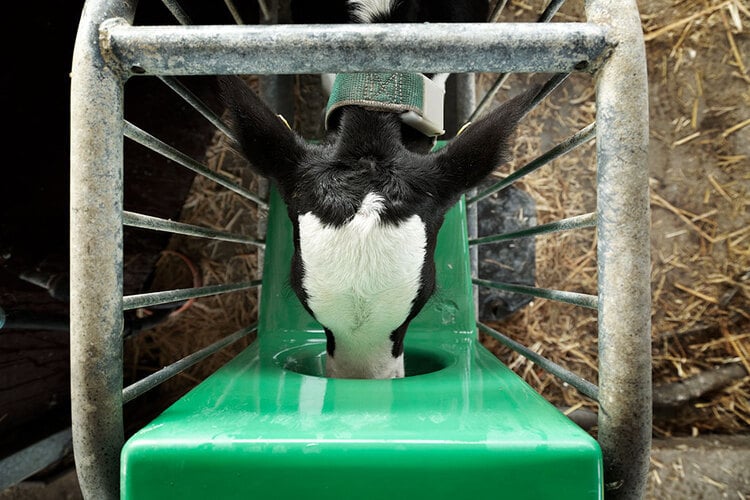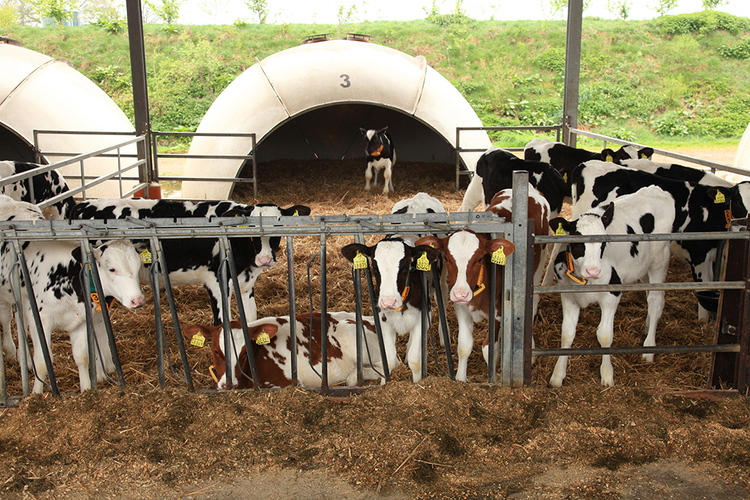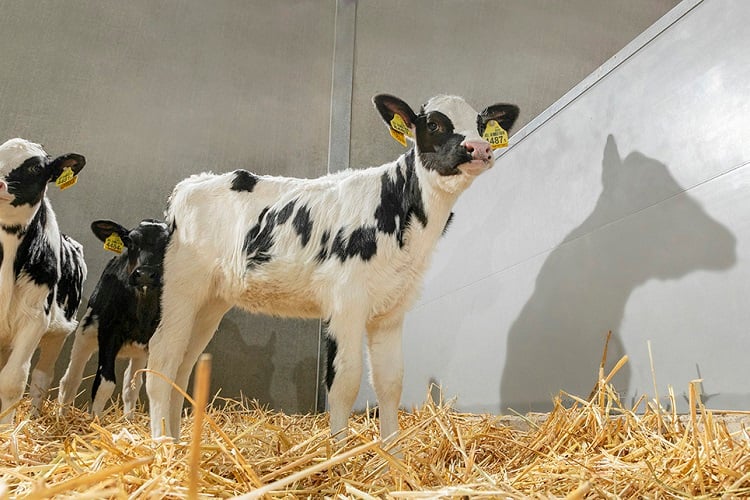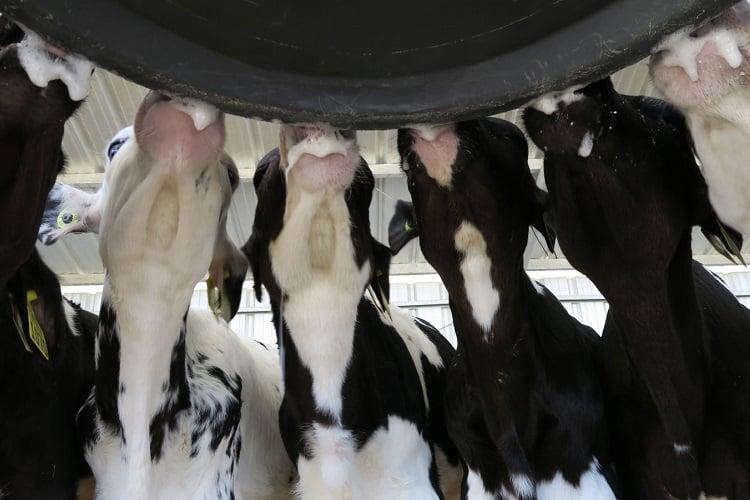- LifeStart
- Preweaning
Key takeaways from the research
-
Automated feeding systems are both labour and cost-efficient.
-
Automated feeding can come closer to the way calves feed in nature, thus increasing animal welfare.
-
Group housing required for automated feeding necessitates good group management.
-
Potential issues of competition can be abated by feeding larger portions of milk and increasing the total amount available.
-
Data collection possible with automated feeding can be positive for calf health and growth outcomes.
-
Autonomy and proximity to natural behaviour that comes with automated feeding can improve public perception.

The advantages of automated feeding with elevated planes of nutrition
The level of nutrition neonatal dairy calves receive is absolutely vital to their health, their short and long-term growth, their welfare and a whole host of other important markers. Historically dairy calves have been limit-fed milk and calf milk replacer (CMR) at about 10% of body weight, as farmers hoped to decrease feeding costs, stimulate early rumen development and increase starter intake.[1] However, feeding larger amounts of milk or CMR helps calves reach breeding size earlier, which decreases age at first calving and the associated costs.[2] Increased growth rates enabled by higher amounts of milk also lead to greater lifetime milk production.[3] When calves have access to feed ad libitum, they consume milk at levels close to 20% of their body weight in small, frequent meals throughout the day. But how best to get calves the additional milk they need has been a problem for many farmers due to labour costs and other ongoing management issues. Automated feeders, however, simplify the task of offering more milk in more meals. In an effort to determine the advantages and disadvantages that come with this technology, researchers at the University of Alberta and the University of British Columbia reviewed the existing literature[4] on automated systems. They found that the current and long-term advantages far outweigh the possible drawbacks.
The advantages of automated feeding
Economic gains that come from labour efficiency are perhaps the most obvious advantage. With automatic feeders, both labour time and costs are dramatically cut. It takes roughly 10% the labour to feed with an auto feeder as it does to do so manually. Advancements in improved health and growth that come from feeding more milk would also spur future economic benefits, by increasing future milk production.
In nature, calves feed up to 10 times per day, slowly reducing in number, but increasing the quantity per feeding, prior to weaning.[5] Thus, automated systems can be more consistent with the natural behaviour of neonatal calves and increase animal welfare. Greater feeding frequency, especially when calves are fed larger volumes of milk, also improves digestion and feed conversion.[6] Increasing the volume of milk fed is good for future milk production, but it's important to note that if that larger amount of milk is fed in only two feedings, it could lead to problems for the calf, if abomasal capacity is surpassed.
Another advantage of automated feeders is that they make later, more gradual weaning feasible. While abrupt and early weaning is still widely practiced, it's been well documented that later, gradual (or step-down) weaning is preferable for continued calf growth and reduction of stress[7]. Automated milk feeders allow for later, more gradual weaning without increasing labour costs and also enable individualized weaning, which could prevent growth checks.
As it was thought that minimising contact with herd mates would reduce the spread of diseases, pre-weaned calves have been housed individually in the past, but researchers now suggest that disease and mortality rates are no worse when calves are housed in small groups. The benefits of group housing include improved feed intake and growth both before and during weaning.[8] That said, as most automated feeding technologies require group housing, it's important to look at how poor group management could result in issues.
Managing automated feeding correctly
While automated feeding systems can be a costly investment, many calves can be fed by one feeder. While this brings up possible issues with group dynamics and competition for access to the feeder, that competition is greatly reduced when both larger portions of milk are fed and the total amount of milk or CMR available is also increased. While non-nutritive suckling, also known as cross-suckling can occur when calves are housed in groups, the answer to this issue is also to feed more milk. Additional strategies can also be employed to reduce cross-suckling, such as making the opening on the artificial teats smaller thereby reducing drinking speed, closing the stall of the feeder station thereby allowing calves to stay longer at feeders and allowing for gradual weaning.
Conclusion
Automated feeding technologies provide many animal welfare advantages. While humans have traditionally been in complete control of feeding milk to calves on farms, with automated feeding, calves can have more control of this themselves, which in itself is more humane. And, with the data collection made possible through automated feeders, the opportunity for individualised feeding exists, as well as the ability to detect illness and to develop remedies such as individualized nutritional management strategies.
Allowing calves more autonomy and feeding closer to their natural way, enhances public perception. Coupled with improved overall calf management, savings in labour costs, and the potential for customisation and individual feeding schemes means automated feeding systems are here to stay.
References
[1] Steele, M.A., J. Rushen, and A.M. de Passillé. 2015. Advancements in Automated Feeding for Calves: Where We Are Today and Where We'll Be Tomorrow. WCDS Advances in Dairy Technology. Volume 27: 49-59.
[2] Davis Rincker, L. E., M. J. VandeHaar, C. A. Wolf, J. S. Liesman, L. T. Chapin, and M. S. Weber Nielsen. 2011. Effect of intensified feeding of heifer calves on growth, pubertal age, calving age, milk yield, and economics. J. Dairy Sci. 94:3554–3567.
[3] Soberon, F., E. Raffrenato, R. W. Everett, and M. E. Van Amburgh. 2012. Preweaning milk replacer intake and effects on long-term productivity of dairy calves. J. Dairy Sci. 95:783-793.
[4] Steele, et al., 2015.
[5] Jensen, M.B. 2003. The effects of feeding method, milk allowance and social factors on milk feeding behaviour and cross-sucking in group-housed dairy calves. Appl Animal Behav Sci. 80:191-206.
[6] van den Borne, J.J.G.C., M.W.A. Verstegen, S.J.J. Alferink, R.M.M. Giebels, and W.J.J. Gerrits. 2006. Effects of feeding frequency and feeding level on nutrient utilization in heavy pre ruminant calves. J. Dairy Sci. 89:3578– 3586
[7] de Passillé, A.M., T.F. Borderas, and J. Rushen. 2011. Weaning age of calves fed a high milk allowance by automated feeders: Effects on feed, water, and energy intake, behavioural signs of hunger, and weight gains. J. Dairy Sci. 94:1401–1408.
[8] De Paula Vieira, A., M.A.G. von Keyserlingk, and D.M. Weary. 2012. Presence of an older weaned companion influences feeding behaviour and improves the performance of dairy calves before and after weaning from milk. J. Dairy Sci. 95:3218–3224.



